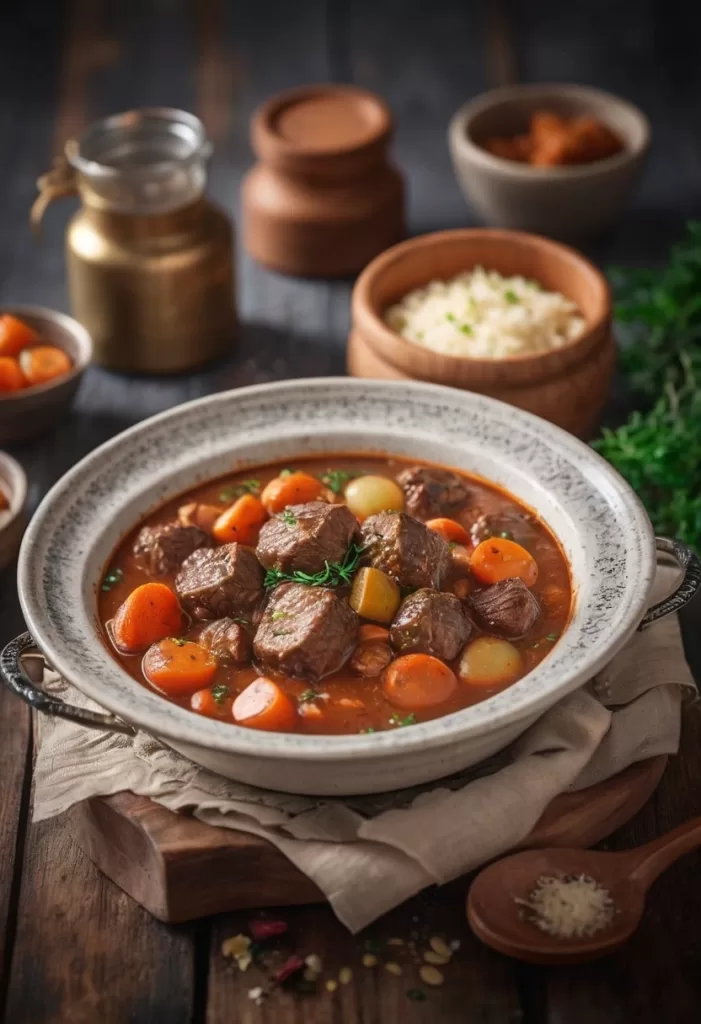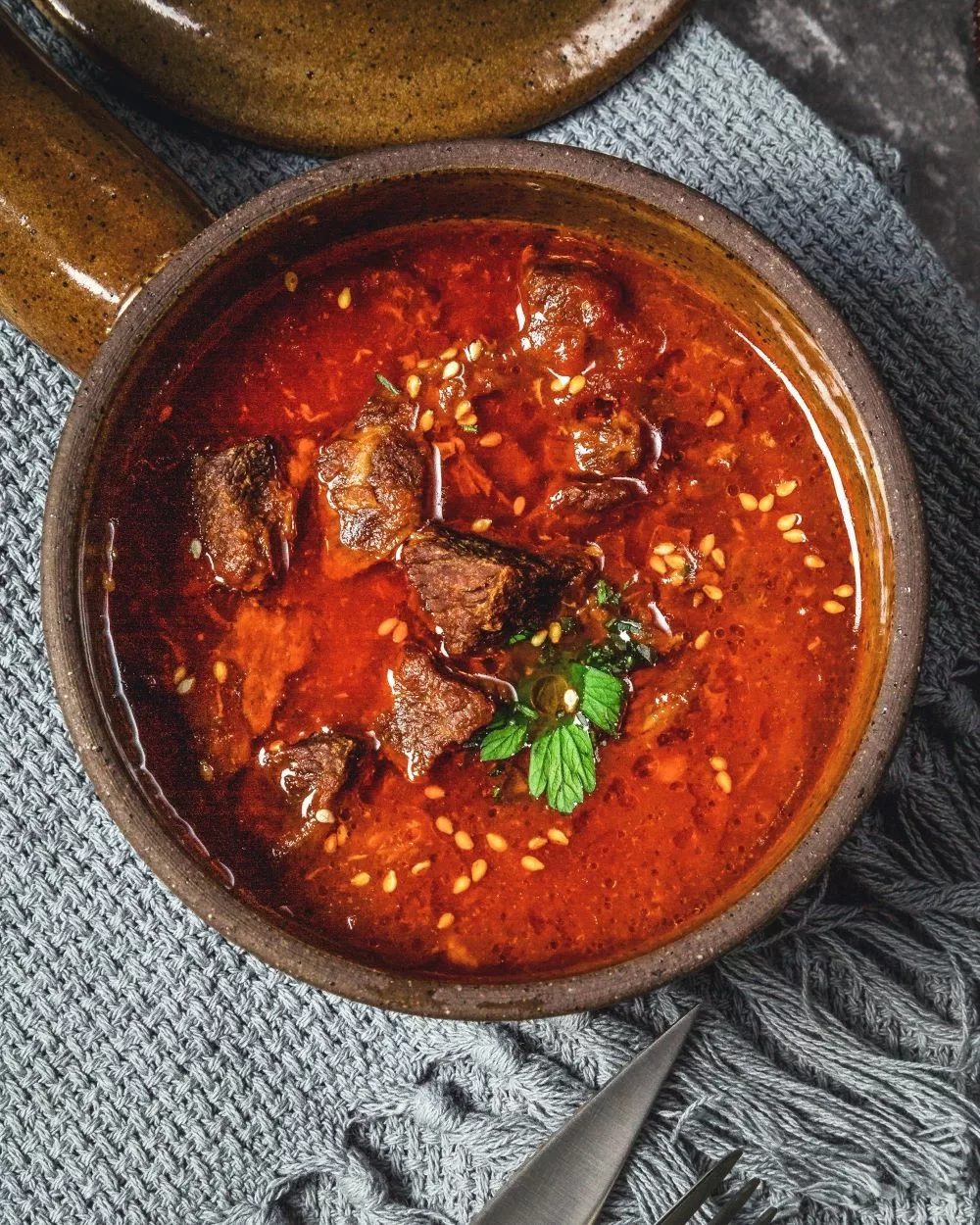Welcome to the ultimate guide to making hearty lamb stew—a classic dish that promises not just warmth and comfort but a delightful journey through rich flavors and textures.
Perfect for a cozy dinner with loved ones, this recipe will walk you through creating a memorable meal that’s both satisfying and nutritious.
Table of Contents
Ingredients
For this lamb stew recipe, you’ll need:
- 1.5 lbs of lamb shoulder, cut into chunks
- 2 tbsp olive oil
- 3 large carrots, peeled and sliced
- 2 onions, chopped
- 4 cloves garlic, minced
- 4 cups beef broth
- 2 cups water
- 3 potatoes, peeled and cubed
- 1 tsp rosemary
- 1 tsp thyme
- Salt and pepper to taste
- 2 tbsp tomato paste
- 1 cup peas (fresh or frozen)
Serves
This recipe serves 4 to 6 people, making it perfect for a family meal or a gathering of close friends.
Step-by-Step Instructions
- Prepare the Ingredients: Start by preparing all your ingredients as listed. This will make the cooking process smoother and faster.
- Brown the Lamb: Heat olive oil in a large pot over medium-high heat. Add the lamb chunks and brown all sides. Remove the lamb and set aside.
- Sauté the Vegetables: In the same pot, add onions, carrots, and garlic. Sauté until onions are translucent.
- Cook the Stew: Return the lamb to the pot. Add beef broth, water, tomato paste, rosemary, thyme, salt, and pepper. Bring to a boil, then reduce to a simmer. Cover and let cook for 1 hour.
- Add Potatoes and Simmer: Add the cubed potatoes to the pot and simmer for another 30 minutes until the potatoes are tender.
- Finish with Peas: Add the peas and cook for an additional 5 minutes. Adjust seasoning as needed.
Serving Suggestions
Serve your lamb stew hot, ideally with a side of crusty bread or over a bed of fluffy rice to soak up the delicious juices.
Lamb stew is more than just a dish; it’s a comforting embrace in edible form. With its rich flavors and hearty ingredients, it stands as a testament to the simplicity and beauty of traditional cooking. Give this recipe a try and bring a touch of comfort to your table.

Tips for Perfect Lamb Stew
- Sear the Lamb Well: This enhances the flavor of the stew.
- Slow Cook: Letting the stew simmer slowly develops depth in the flavor.
- Fresh Herbs: Use fresh rosemary and thyme if possible for the best taste.
Healthier Alternatives
- Reduce the Fat: Trim excess fat from the lamb and use less oil.
- Low-Sodium Broth: Opt for a low-sodium beef broth to reduce overall salt intake.
Creative Variations
- Add Different Veggies: Try adding sweet potatoes or turnips for a different twist.
- Spice It Up: Incorporate a pinch of cayenne or paprika for a little heat.
Common Mistakes to Avoid
- Overcrowding the Pot: Cook the lamb in batches if necessary to ensure it browns properly.
- Rushing the Cooking: Lamb stew is best when given time to develop its flavors fully.
History of Lamb Stew
Lamb stew has been a staple in many cultures around the world, known for its hearty and nourishing properties, with variations seen from Europe to North Africa.
Lamb stew is a dish steeped in history, dating back centuries across various cultures around the world. Its roots are often traced back to ancient times when it was essential for dishes to be both filling and capable of being cooked in a single pot over an open fire.
This practicality made stewed dishes popular among peasants and travelers alike.
In Europe, lamb stew became a staple in countries like Ireland, Scotland, and France, where sheep farming was prevalent and lamb was readily available.
Each region developed its own unique version of lamb stew, incorporating local herbs and ingredients. For instance, Irish stew, originally called “stobhach gaelach,” was a simple dish made from lamb, potatoes, and onions.
It was a practical dish that could feed many and could be left over a low fire for hours, allowing flavors to meld together.
In the Middle East and North Africa, lamb has been a central part of the diet due to the pastoral nomadic lifestyle of many of its people.
Here, lamb stew often includes a variety of spices like cumin, coriander, and cinnamon, reflecting the rich spice trade history of the region.
The significance of lamb stew also extends to its nutritional value. In historical contexts where food could be scarce and work demanding, lamb stew provided essential nutrients from a mix of meat, vegetables, and broth, all cooked slowly to preserve and enhance the nutrient content.
Today, lamb stew is celebrated not just for its hearty and comforting nature but also for its ability to connect us to our past through culinary traditions that have been passed down through generations.
It remains a beloved dish around the world, appreciated for its rich flavors and cultural significance.
FAQs about Lamb Stew
1. Can I use another type of meat?
Yes, beef or chicken can also be used, though cooking times may vary.
2. How long can I store lamb stew?
Properly stored in the refrigerator, lamb stew can last up to 3-4 days.
3. Is lamb stew suitable for freezing?
Absolutely! Freeze it in airtight containers for up to 3 months.
4. What’s the best way to reheat lamb stew?
Gently reheat on the stove over low heat to preserve the flavors.
5. Can I make this stew in a slow cooker?
Yes, after browning the meat and sautéing the vegetables, transfer everything to a slow cooker and cook on low for 7-8 hours.
6. What are the best herbs to use in lamb stew?
Rosemary and thyme are classic, but bay leaves and parsley also work well.
7. Can lamb stew be made ahead of time?
Yes, making it a day ahead can actually enhance the flavors as they meld together in the fridge.
8. What can I substitute for peas?
Green beans or chopped spinach make excellent substitutes.


